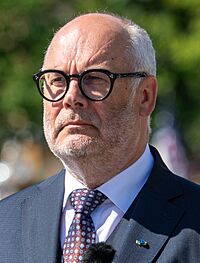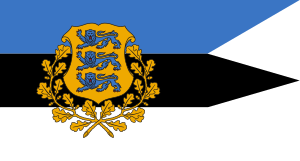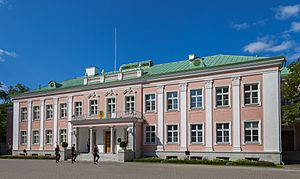President of Estonia facts for kids
Quick facts for kids President of the Republic of Estonia |
|
|---|---|

Presidential Standard
|
|
| Style | Mr President (informal) His Excellency (diplomatic) |
| Residence | Presidential Palace, Tallinn |
| Appointer | Riigikogu / Electoral College (alternately until a candidate reaches the required majority) |
| Term length | Five years,
renewable once consecutively
|
| Constituting instrument | Constitution of Estonia (1992) |
| Inaugural holder | Konstantin Päts |
| Formation | 24 April 1938 |
| Abolished | 1940–1991 |
| Deputy | Speaker of the Riigikogu |
| Salary | €6,661.77 monthly |
The President of the Republic of Estonia (Estonian: Eesti Vabariigi President) is the head of state for Estonia. This means they are the country's top representative. The current president is Alar Karis. He was chosen by the Estonian Parliament on August 31, 2021. He took over from Kersti Kaljulaid.
Estonia is a parliamentary republic. In this system, the president's job is mostly ceremonial. They do not have direct power over the government. To be fair, the president must stop being a member of any political party. They also leave any other jobs they had when they become president. This helps them stay independent and neutral. A president serves for five years. They can be elected many times, but only twice in a row.
Contents
How the President is Chosen
In Estonia, the president is elected by the Riigikogu, which is the Estonian Parliament. A candidate needs to get two-thirds of the votes to win. If no one gets enough votes after three tries, a special group is formed. This group includes all members of the Riigikogu. It also includes representatives from all Estonian towns and cities. Each municipality sends at least one person. Bigger municipalities send more representatives. This special group then chooses between the top two candidates.
Some people think this election process should change. They believe the public should vote directly for the president. However, most members of parliament do not agree with this idea.
History of the Estonian Presidency
The people who wrote Estonia's first constitution wanted to avoid giving too much power to one person. They remembered how Russian emperors had abused their power. So, they created a system where the Parliament had almost all the power.
Early Leaders: State Elder
Until 1934, the country's leader was called the State Elder (riigivanem). This person was also the head of the government. But they could not really balance power between the Parliament and the government. The State Elder and the government depended completely on the Parliament. The Parliament could remove them from office at any time. The jobs that a president usually does were split among different people. These included the speaker of the Riigikogu, the State Elder, and the government.
Changes to the Constitution
In 1933, Estonia's constitution was changed. This new plan would have given the State Elder a lot of power. However, this change never fully happened. This was because Konstantin Päts took control in 1934. In 1938, a new constitution was made. The leader's title was changed to "President of the Republic." This president had broad powers, but less than the 1933 plan. Konstantin Päts became the first person to be called President. His term was supposed to last six years.
During Soviet Occupation
In June 1940, the Soviet military occupied Estonia. President Päts was forced to appoint a government chosen by Soviet officials. After fake elections, President Päts was removed from office. He and his family were sent away to Russia.
According to the 1938 constitution, if the president could not do their job, the prime minister would take over. This person would be called "Prime Minister in duties of the President." Johannes Vares took on this role for a short time during the Soviet occupation. But in April 1944, a special council decided that Vares's appointment was not legal. They elected Jüri Uluots as acting president.
Many Estonian leaders, including Uluots, later escaped to Sweden. They continued to act as the Estonian government from outside the country. This group kept the idea of an independent Estonia alive during the Soviet era. In October 1992, after Estonia became independent again, Heinrich Mark, the last acting president in exile, handed over his duties to the newly elected president, Lennart Meri.
Presidency in Modern Estonia
After Estonia regained its independence, a new constitution was created in 1992. It combined ideas from the 1920 and 1938 documents. People first thought about using the old title "State Elder." But they chose the more modern term "president" after public discussions.
Since 1992, there have been seven presidential elections. Lennart Meri was elected in 1992 and again in 1996. Arnold Rüütel became president in 2001. In 2006, Toomas Hendrik Ilves won the election and was reelected in 2011. Kersti Kaljulaid became president in 2016. The Parliament elected Alar Karis as president in 2021.
What the President Does
The President of the Republic of Estonia has several important duties:
- Represents Estonia: The president is Estonia's main representative in international affairs. They sign international agreements that the government has approved. Sometimes, they can even represent Estonia in the European Council if the Prime Minister is not there.
- Diplomacy: They appoint and recall Estonia's ambassadors to other countries and international groups. They also receive official papers from foreign diplomats who come to Estonia.
- Elections: The president announces regular elections for the Riigikogu (Parliament). They can also call for special elections in certain situations. For example, if the Parliament cannot pass the national budget.
- Parliamentary Duties: They bring together the new members of the Riigikogu and open its first meeting. They can also ask the Riigikogu to hold special meetings if needed.
- Laws: The president signs new laws. They can refuse to sign a bill if they think it goes against the Constitution of Estonia. If this happens, they send the bill back to the Riigikogu with their reasons. The Riigikogu can then change the bill, drop it, or pass it again without changes. If the Riigikogu passes it again, the president must sign it or ask the Supreme Court to decide if it is constitutional.
- Constitutional Changes: The president can suggest changes to the Constitution. This right has been used only twice so far.
- Government Appointments: They suggest a candidate for Prime Minister after talking with political groups in Parliament. This person is usually the leader of the biggest party or group in Parliament. The Parliament then votes to approve this candidate. The president also formally appoints and dismisses government members based on the Prime Minister's suggestions.
- Other Appointments: The president nominates important officials. These include the head of the Supreme Court, the head of the Bank of Estonia, and the Auditor General. These nominations must be approved by the Parliament.
- Military Role: The president is the Supreme Commander of Estonia's National Defence Forces. This role is mostly ceremonial. The Ministry of Defence usually manages the Defence Forces.
- Emergency Powers: They can propose to the Riigikogu to declare martial law or a state of emergency. They can also declare martial law and order mobilization if Estonia is attacked.
- State Defence Council: The president leads the State Defence Council. This group advises on national defense. It includes the prime minister, the speaker of the Riigikogu, and several ministers.
- Pardons: The president can release or reduce sentences for people who have been found guilty of crimes.
Unlike presidents in some other countries, the Estonian president does not lead the government directly. The Constitution clearly states that the government holds the executive power.
List of Presidents
| No. | Portrait | Name | Took office | Left office | Party | Birth and death |
|---|---|---|---|---|---|---|
| 1 | 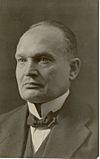 |
Konstantin Päts | 24 April 1938 | 23 July 1940 | b. 23 February 1874, Tahkuranna d. 18 January 1956, Burashevo, Kalinin Oblast, USSR |
|
| 1938 – I round – elected by the Electoral Assembly (parliament and municipal appointees) with 219 of 238 votes (92.0%). | ||||||
| 2 | 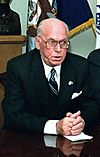 |
Lennart Meri | 6 October 1992 | 8 October 2001 | Pro Patria National Coalition | b. 29 March 1929, Tallinn d. 14 March 2006, Tallinn |
| 1992 – II round – elected by the parliament with 59 of 101 votes (58.4%). 1996 – V round – elected by the Electoral Assembly (parliament and municipal appointees) with 196 of 372 votes (52.7%). |
||||||
| 3 | 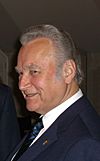 |
Arnold Rüütel | 8 October 2001 | 9 October 2006 | People's Union of Estonia | b. 10 May 1928, Laimjala Parish, Saare County d. 31 December 2024 |
| 2001 – V round – elected by the Electoral Assembly (parliament and municipal appointees) with 186 of 366 votes (50.8%). | ||||||
| 4 |  |
Toomas Hendrik Ilves | 9 October 2006 | 10 October 2016 | Social Democratic Party | b. 26 December 1953, Stockholm, Sweden |
| 2006 – IV round – elected by the Electoral Assembly (parliament and municipal appointees) with 174 of 345 votes (50.4%). 2011 – I round – elected by the parliament with 73 of 101 votes (72.3%). |
||||||
| 5 |  |
Kersti Kaljulaid | 10 October 2016 | 11 October 2021 | Independent | b. 30 December 1969, Tartu |
| 2016 – VI round – elected by the parliament with 81 of 101 votes (80.2%). | ||||||
| 6 | 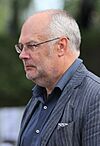 |
Alar Karis | 11 October 2021 | Incumbent | Independent | b. 26 March 1958, Tartu |
| 2021 – II round – elected by the parliament with 72 of 101 votes (71.3%). | ||||||
See also
 In Spanish: Presidente de Estonia para niños
In Spanish: Presidente de Estonia para niños
- First Lady of Estonia
- Prime Minister of Estonia
- State Elder of Estonia
- Riigihoidja
- List of chairmen of the Presidium of the Supreme Soviet of the Estonian Soviet Socialist Republic ("head of state" during the Soviet era)


